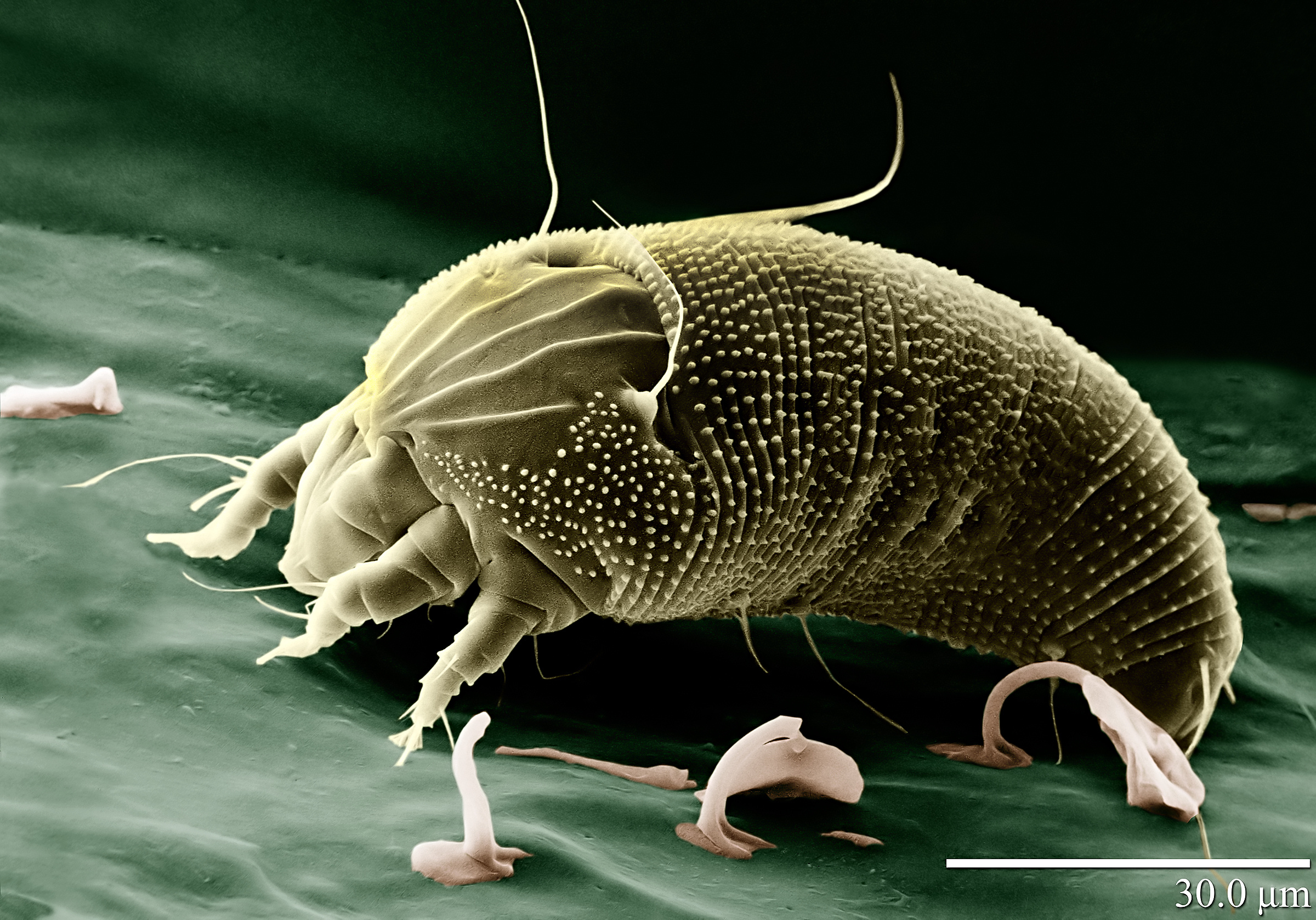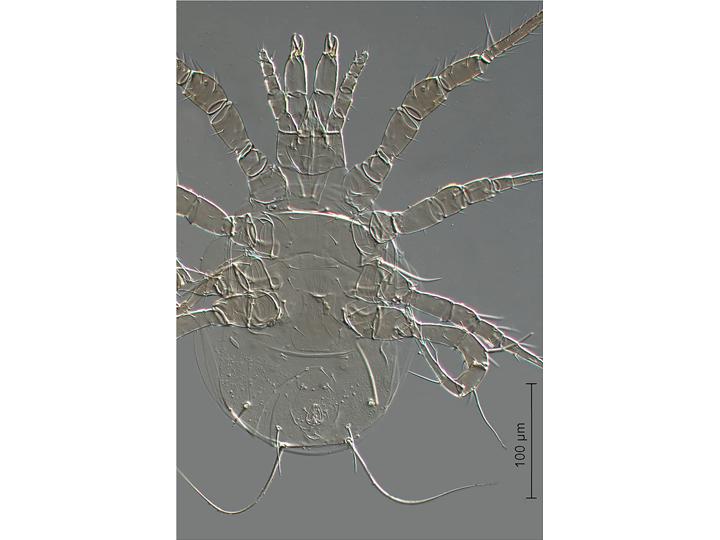|
Aceria Chondrillae
''Aceria chondrillae'' (chondrilla gall mite, skeletonweed gall mite) is a gall forming deuterogynous, eriophyid (mite) often used as a biological control of the noxious weed, ''Chondrilla juncea'' (Rush skeletonweed), a highly competitive herbaceous perennial composite found in Europe, Asia, Australia and North America.Krantz, G.W. and Ehrensing, D.T. (1990). ‘Deuterogyny in the Skeleton Weed Mite, Aceria Chondrillae (G. Can.) (Acari: Eriophyidae)’, International Journal of Acarology, Vol. 16, No 3, pp 129-133. Biological description At maturity, mites are yellowish orange in colour, with females ranging from 0.19-0.26 mm in length with the males slightly smaller at, 0.165-0.180 mm.Powell G.W., Sturko A., Wikeem B.M., Harris P. (1994). ‘Field Guide to the Biological Control of Weeds in British Columbia’, British Columbia Ministry Forest Research Program Land Management, pp. 55-56. Except for genitalia male and female mites are externally similar. Larvae are sma ... [...More Info...] [...Related Items...] OR: [Wikipedia] [Google] [Baidu] |
Canestrini
Giovanni Canestrini (26 December 1835 – 14 February 1900) was an Italian naturalist and biologist and translator who was a native of Revò. Career He initially studied in Gorizia and Meran, then furthered his education in natural sciences at the University of Vienna. From 1862 to 1869, he was a lecturer at the University of Modena, and in 1869 became a professor of zoology and comparative anatomy at the University of Padua. In 1862 he founded the ''Società dei Naturalisti Modenesi'' (Modena Society of Naturalists), and in 1871, the ''Società Veneto-Trentina di Scienze Naturali'' (Trento-Venetian Society of Natural Sciences). He is credited with establishment of the bacteriology laboratory at Padua. Canestrini made contributions in several biological disciplines, performing important research in the field of acarology. He was an advocate of Darwinism, and was responsible for translating Darwin's works. In 1864, he was the first to translate Darwin's ''On the Origin of Specie ... [...More Info...] [...Related Items...] OR: [Wikipedia] [Google] [Baidu] |
Eriophyid
Eriophyidae is a family of more than 200 genera of mites, which live as plant parasites, commonly causing galls or other damage to the plant tissues and hence known as gall mites. About 3,600 species have been described, but this is probably less than 10% of the actual number existing in this poorly researched family. They are microscopic mites and are yellow to pinkish white to purplish in color. The mites are worm like, and have only two pairs of legs. Their primary method of population spread is by wind. They affect a wide range of plants, and several are major pest species causing substantial economic damage to crops. Some species, however, are used as biological agents to control weeds and invasive plant species. Notable species Notable species in this family include: *''Abacarus hystrix'', the cereal rust mite *'' Abacarus sacchari'', the sugarcane rust mite *'' Acalitus essigi'', the redberry mite, which affects blackberries *''Aceria chondrillae'', the chondrilla gall ... [...More Info...] [...Related Items...] OR: [Wikipedia] [Google] [Baidu] |
Biological Control
Biological control or biocontrol is a method of controlling pests, such as insects, mites, weeds, and plant diseases, using other organisms. It relies on predation, parasitism, herbivory, or other natural mechanisms, but typically also involves an active human management role. It can be an important component of integrated pest management (IPM) programs. There are three basic strategies for biological pest control: classical (importation), where a natural enemy of a pest is introduced in the hope of achieving control; inductive (augmentation), in which a large population of natural enemies are administered for quick pest control; and inoculative (conservation), in which measures are taken to maintain natural enemies through regular reestablishment. Natural enemies of insect pests, also known as biological control agents, include predators, parasitoids, pathogens, and competitors. Biological control agents of plant diseases are most often referred to as antagonists. Biologic ... [...More Info...] [...Related Items...] OR: [Wikipedia] [Google] [Baidu] |
Noxious Weed
A noxious weed, harmful weed or injurious weed is a weed that has been designated by an agricultural or other governing authority as a plant that is injurious to agricultural or horticultural crops, natural habitats or ecosystems, or humans or livestock. Most noxious weeds have been introduced into an ecosystem by ignorance, mismanagement, or accident. Some noxious weeds are native. Typically they are plants that grow aggressively, multiply quickly without natural controls (native herbivores, soil chemistry, etc.), and display adverse effects through contact or ingestion. Noxious weeds are a large problem in many parts of the world, greatly affecting areas of agriculture, forest management, nature reserves, parks and other open space. Many noxious weeds have come to new regions and countries through contaminated shipments of feed and crop seeds or were intentionally introduced as ornamental plants for horticultural use. Some "noxious weeds", such as ragwort, produce copious amou ... [...More Info...] [...Related Items...] OR: [Wikipedia] [Google] [Baidu] |
Chondrilla Juncea
''Chondrilla juncea'' is a species of flowering plant in the family Asteraceae known by a number of common names, including rush skeletonweed, gum succory, devil's grass, and nakedweed. The plant is native to Europe, Asia, and North Africa, but it is known throughout most temperate regions of the world as an introduced species which is usually considered a noxious weed. Description It is a thin, spindly plant which reaches a meter in height. It starts from a basal rosette of leaves and branches extensively, often forming a weedy thicket. It produces small dandelionlike flowers with rectangular yellow ray florets. The fruit is an achene about a centimeter long topped with a white pappus. It reproduces by seed but also by cloning itself at the root; tilling of soil and chopping up plants actually help this species disperse by sectioning and distributing root parts. Distribution Native From the Aral Sea area in Kazakhstan and Uzbekistan in Central Asia, westward through Russia, th ... [...More Info...] [...Related Items...] OR: [Wikipedia] [Google] [Baidu] |
Skeletonweed Gall Mite 0022094-PPT
Skeletonweed is a common name for many species of plants, including: *''Chaetadelpha wheeleri'', an asterid *''Chondrilla juncea'', an invasive asterid *''Eriogonum deflexum'', a buckwheat *''Pleiacanthus spinosus ''Pleiacanthus'' is a monotypic genusLee, J., et al. (2002)Phylogeny of ''Stephanomeria'' and related genera (Compositae–Lactuceae) based on analysis of 18S–26S nuclear rDNA ITS and ETS sequences.''Am J Bot'' 89 160-8. of flowering plants in t ...'', an asterid *'' Shinnersoseris'' spp. of the asterids {{Plant common name ... [...More Info...] [...Related Items...] OR: [Wikipedia] [Google] [Baidu] |
Skeletonweed Gall Mite 0022095-SMPT
Skeletonweed is a common name for many species of plants, including: *''Chaetadelpha wheeleri'', an asterid *''Chondrilla juncea'', an invasive asterid *''Eriogonum deflexum'', a buckwheat *''Pleiacanthus spinosus ''Pleiacanthus'' is a monotypic genusLee, J., et al. (2002)Phylogeny of ''Stephanomeria'' and related genera (Compositae–Lactuceae) based on analysis of 18S–26S nuclear rDNA ITS and ETS sequences.''Am J Bot'' 89 160-8. of flowering plants in t ...'', an asterid *'' Shinnersoseris'' spp. of the asterids {{Plant common name ... [...More Info...] [...Related Items...] OR: [Wikipedia] [Google] [Baidu] |
Phytoseiidae
The Phytoseiidae are a family of mites which feed on thrips and other mite species. They are often used as a biological control agent for managing mite pests. Because of their usefulness as biological control agents, interest in Phytoseiidae has steadily increased over the past century. Public awareness of the biological control potential of invertebrates has been growing, though mainly in the US and Europe. In 1950, there were 34 known species. Today, there are 2,731 documented species organized in 90 genera and three subfamilies. Subfamilies The family Phytoseiidae contains these subfamilies: * Amblyseiinae Muma, 1961 * Phytoseiinae Berlese, 1916 * Typhlodrominae Scheuten, 1857 Anatomy and life cycle Phytoseiid eggs can be found along the vein of the bottom side of a leaf; They are oblong and translucent white. The larvae of these mites range from translucent white to tan in colour. They are tiny and oval in shape and size, have six legs, and are wingless. Nymphs look simil ... [...More Info...] [...Related Items...] OR: [Wikipedia] [Google] [Baidu] |
Amblyseius
''Amblyseius'' is a large genus of predatory mites belonging to the family Phytoseiidae.de Moraes, G. J. (2005)Phytoseiidae Species Listing Biology Catalog, Texas A&M University. Retrieved on August 19, 2010. Many members of this genus feed on other mites such as red spider mites, and also on thrips. Several species are popular as biological control agents to control these pests. Species A * '' Amblyseius abbasovae'' Wainstein & Beglyarov, 1971 * ''Amblyseius acalyphus'' Denmark & Muma, 1973 * '' Amblyseius adhatodae'' Muma, 1967 * '' Amblyseius adjaricus'' Wainstein & Vartapetov, 1972 * '' Amblyseius aequipilus'' Berlese, 1914 * ''Amblyseius aerialis'' (Muma, 1955) * ''Amblyseius alpigenus'' Wu, 1987 * ''Amblyseius alpinia'' Tseng, 1983 * ''Amblyseius americanus'' Garman, 1948 * ''Amblyseius ampullosus'' Wu & Lan, 1991 * ''Amblyseius anacardii'' De Leon, 1967 * ''Amblyseius andersoni'' (Chant, 1957) * '' Amblyseius angulatus'' Karg, 1982 * ''Amblyseius animos'' Khan, Afzal & ... [...More Info...] [...Related Items...] OR: [Wikipedia] [Google] [Baidu] |
Eriophyidae
Eriophyidae is a family of more than 200 genera of mites, which live as plant parasites, commonly causing galls or other damage to the plant tissues and hence known as gall mites. About 3,600 species have been described, but this is probably less than 10% of the actual number existing in this poorly researched family. They are microscopic mites and are yellow to pinkish white to purplish in color. The mites are worm like, and have only two pairs of legs. Their primary method of population spread is by wind. They affect a wide range of plants, and several are major pest species causing substantial economic damage to crops. Some species, however, are used as biological agents to control weeds and invasive plant species. Notable species Notable species in this family include: *''Abacarus hystrix'', the cereal rust mite *'' Abacarus sacchari'', the sugarcane rust mite *'' Acalitus essigi'', the redberry mite, which affects blackberries *''Aceria chondrillae'', the chondrilla gall ... [...More Info...] [...Related Items...] OR: [Wikipedia] [Google] [Baidu] |
Invasive Plants Biological Control Agents
{{disambig ...
Invasive may refer to: *Invasive (medical) procedure *Invasive species *Invasive observation, especially in reference to surveillance *Invasively progressive spread of disease from one organ in the body to another, especially in reference to cancer, see invasion (cancer) See also *Intruder (other) *Invasion (other) *Intrusive (other) *Invasive procedure (other) Invasive procedure may refer to: * "Invasive Procedures" (''Star Trek: Deep Space Nine''), the fourth episode of the second season of the television series ''Star Trek: Deep Space Nine'' * ''Invasive Procedures'' (novel), a 2007 novel by Orson Sc ... [...More Info...] [...Related Items...] OR: [Wikipedia] [Google] [Baidu] |
Arachnids Of Asia
Arachnida () is a Class (biology), class of joint-legged invertebrate animals (arthropods), in the subphylum Chelicerata. Arachnida includes, among others, spiders, scorpions, ticks, mites, pseudoscorpions, opiliones, harvestmen, Solifugae, camel spiders, Amblypygi, whip spiders and Thelyphonida, vinegaroons. Almost all adult arachnids have eight Arthropod leg, legs, although the front pair of legs in some species has converted to a sensory function, while in other species, different appendages can grow large enough to take on the appearance of extra pairs of legs. The term is derived from the Ancient Greek, Greek word (''aráchnē'', 'spider'), from the myth of the hubristic human weaver Arachne, who was turned into a spider. Almost all Extant taxon, extant arachnids are terrestrial animal, terrestrial, living mainly on land. However, some inhabit freshwater environments and, with the exception of the pelagic zone, marine environments as well. They comprise over 100,000 named ... [...More Info...] [...Related Items...] OR: [Wikipedia] [Google] [Baidu] |







